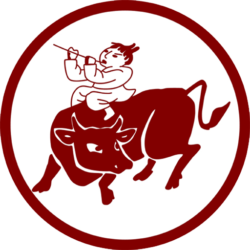I graduated from my third year of study with Bill Palmer in Movement Shiatsu. I studied for the first two years with another school, but toward the end of the second year felt increasingly stuck in my shiatsu. One of the main reasons I had been drawn to Shiatsu was because it cut through intellectual theorising with simple human touch, but was feeling increasingly alienated by ever more techniques and theory. Somehow the original joy and spontenaeity were being replaced by another set of ideas.
Although the past year has been difficult in the sense that many of my ideas about Shiatsu have been challenged, I feel that I have regained something of “the beginner’s mind”!
The shiatsu I had done before seemed to be concerned with removing “blockages” to recreate the “model human”, whereas the Movement Shiatsu I have done seems to be concerned with evolution of the human being along an unchartered path. For me this is much more exiting as we are exploring the unknown rather than working towards a fixed model of “perfection”. It also allows room for many different paths, as the more different paths people follow the more enriched we all become. Like evolution, there is much trial and error: the evolutionary “blind alleys” (the dinosaurs) and the sudden unexpected breakthroughs (such as the eye).
Like evolution, Movement Shiatsu is very much a learning process. Bill talks about meridians being pathways along which we learn to inhabit our own bodies, and I like very much the idea that consciousness somehow explores matter (ie the body) through the meridians. I have heard of chi being the bridge between mind and matter, and this seems to fit in with what Bill was talking about.
Indeed, Movement Shiatsu has allowed me to make sense of the meridians at last. I can integrate them into my own experience, and integrate what they are saying more fully with other information from clients. Following on from the above paragraph, I imagine the meridians as “feelers” going out to explore the body, collecting information about how it can be moved. As the information is sorted out the mind structure develops in tandem with the body. Over time the information flows solidify into patterns, both in the structure of the nervous system and in the thought/emotional processes. In order that we don’t have to spend lots of energy calculating the most efficient way to move each time (in the higher brain), we develop more and more fixed, automatic movements and reflexes (in the lower, reptilian brain).
However, what may be an appropriate movement at one time may cease being appropriate at a later date, and we may end up using outmoded ways of moving. For example, in what Bill calls the Earth phase of development, a lack of support may produce a constant stretching of the stomach meridian as the baby tries to reach out for what it is not being given. While this behaviour may be appropriate for the baby, the pattern may solidify into constant tension, which may continue to exist long after they individual has grown up and is able to feed himself. Similarly, on the emotional side, the individual may end up with a yearning for the unattainable, instead of finding other ways to satisfy himself, and enjoying what is attainable. For me this is the crux of Movement Shiatsu: to give the body/mind new possibilities of organising itself.
As I mentioned above, this is not trying to force it into the “perfect mold”, it is giving it the freedom to explore its own new paths, or indeed to decide it wishes to stay how it is! In this case, for example, we may use Earth touch to show the body/mind that support and nourishment can be obtained in other ways, and that it was not the reaching out by certain muscles that produced the fulfillment. Based on this new information, the body/mind may decide to adopt new strategies for gaining support.
Of course, the reprogramming gets harder with age as patterns become ever more solidified: I imagine certain avenues for change becoming more and more overgrown with weeds until the path becomes very hard to find!
I have been particularly able to relate to the work we have done on the shadow. While my intellect “knew” that the concept of “kyo” related to the unseen, it brought it to life for me when it was related to the unconscious. It is those parts of ourselves that we are not in contact with, that we have not integrated into our personalities. It is those parts of the body we do not live in, those parts of the mind we like to think we do not have (anger, lust etc.). Once again this brought the meridians to life for me: they are not some ancient abstract text, but larger than life Jungian archetypes! They feel more like long lost friends now!
Another thing I’ve gained from Movement Shiatsu is the idea of clients taking much more responsibility for their own development, instead of collapsing into my arms once a week and being patched up until next time.
Beforehand I would rarely speak while giving a treatment as I felt it disturbed the flow. Now I find that getting the client to do certain things for themselves gives a tremendous sense of self empowerment: such as breathing to a certain area, or feeling for themselves how they are not letting go an arm. The client is no longer reliant on me to transmit some mystical force! It is also more fun for me to share my knowledge with people, rather than them looking up to me as some sort of guru with secrets.
Most importantly, it is helping the receiver to expand their consciousness of their own process. For example, one woman was amazed at the connection between her mind and body: she had very tight rhomboids, and also repressed anger at her husband, but had never connected the two. When I was working the muscle I asked her whether she thought there was any connection with her feelings for her husband: when she saw the connection she was at last able to release! She was so excited at learning about the mind/body connection, she went away like a child with a new toy: and it was HER toy, not mine! I feel that if we explain to people what we are doing, and relate it to their own experience, the more they can do for themselves, and the more shiatsu is demystified.
Finally, Movement Shiatsu makes me feel even more so that intelligence/consciousness resides in every part of us, rather than just in the brain. Dethlefson & Dahlke suggest that it may be contained in each cell’s nucleus, and Zohar even suggests that electrons may be conscious! I feel that with bodywork we are educating the cells directly, showing them new possibilities, rather than just teaching the brain. Certainly the brain seems to have a function of absorbing information and rationalising it, but I feel that the cells have their own capacity for reorganisation, and that there may well be other structures which also do. If chi is “intelligent” then intelligence must exist in inanimate objects also: maybe we are part of consciousness rather than consciousness being part of us!.
by Henry McGrath, now a well known practitioner of Chinese Medicine in Bristol

